Ultra-Low-Reflective, Self-Cleaning Surface by Fabrication Dual-Scale Hierarchical Optical Structures on Silicon
Abstract
1. Introduction
2. Experimental Section
2.1. Materials
2.2. Fabrication of Dual-Scale Hierarchical Micro-Nano-Structured Optical Surface
2.3. Performance Characterization
3. Results and Discussion
3.1. Fabrication of Micro-Scale Pyramidal Structure
3.2. Fabrication of Dual-Scale Hierarchical Structures
3.3. Optical Properties of Surfaces with Dual-Scale Hierarchical Structures
3.4. Wettability of Surfaces with Dual-Scale Hierarchical Structures
4. Conclusions
Author Contributions
Funding
Institutional Review Board Statement
Informed Consent Statement
Data Availability Statement
Conflicts of Interest
References
- Ye, X.; Huang, J.; Ni, R.F.; Yi, Z.; Zheng, W.G. Broadband antireflection and self-cleaning random grass structure on silicon. J. Optoelectron. Adv. Mater. 2015, 17, 192–197. [Google Scholar]
- Zeng, Y.; Fan, X.; Chen, J.; He, S.; Yi, Z.; Ye, X.; Yi, Y. Preparation of composite micro/nano structure on the silicon surface by reactive ion etching: Enhanced anti-reflective and hydrophobic properties. Superlattices Microstruct. 2018, 117, 144–154. [Google Scholar] [CrossRef]
- Yang, C.; Jing, X.; Wang, F.; Ehmann, K.F.; Tian, Y.; Pu, Z. Fabrication of controllable wettability of crystalline silicon surfaces by laser surface texturing and silanization. Appl. Surf. Sci. 2019, 497, 143805. [Google Scholar] [CrossRef]
- Liu, S.; Niu, X.; Shan, W.; Lu, W.; Zheng, J.; Li, Y.; Duan, H.; Quan, W.; Han, W.; Wronski, C.R. Improvement of conversion efficiency of multicrystalline silicon solar cells by incorporating reactive ion etching texturing. Sol. Energy Mater. Sol. Cells 2014, 127, 21–26. [Google Scholar] [CrossRef]
- Chen, W.H.; Hong, C.N. 0.76% absolute efficiency increase for screen-printed multicrystalline silicon solar cells with nanostructures by reactive ion etching. Sol. Energy Mater. Sol. Cells 2016, 157, 48–54. [Google Scholar] [CrossRef]
- Rajkanan, K.; Singh, R.; Shewchun, J. Absorption coefficient of silicon for solar cell calculations—ScienceDirect. Solid-State Electron. 1979, 22, 793–795. [Google Scholar] [CrossRef]
- Saga, T. Advances in crystalline silicon solar cell technology for industrial mass production. Npg Asia Mater. 2010, 2, 96–102. [Google Scholar] [CrossRef]
- Huang, Z.; Carey, J.E.; Liu, M.; Guo, X.; Mazur, E.; Campbell, J.C. Microstructured silicon photodetector. Appl. Phys. Lett. 2006, 89, 516. [Google Scholar] [CrossRef]
- Beam, J.C.; Leblanc, G.; Gizzie, E.A.; Ivanov, B.L.; Needell, D.R.; Shearer, M.J.; Jennings, G.K.; Lukehart, C.M.; Cliffel, D.E. Construction of a Semiconductor–Biological Interface for Solar Energy Conversion: P-Doped Silicon/Photosystem I/Zinc Oxide. Langmuir Acs J. Surf. Colloids 2015, 31, 10002–10007. [Google Scholar] [CrossRef]
- Lee, C.; Bae, S.Y.; Mobasser, S.; Manohara, H. A novel silicon nanotips antireflection surface for the micro sun sensor. Nano Lett. 2005, 5, 2438–2442. [Google Scholar] [CrossRef]
- Zhang, D.; Ren, W.; Zhu, Z.; Zhang, H.; Liu, B.; Shi, W.; Qin, X.; Cheng, C. Highly-ordered silicon inverted nanocone arrays with broadband light antireflectance. Nanoscale Res. Lett. 2015, 10, 9. [Google Scholar] [CrossRef]
- Chang, L.; Qiu, R.; Wen, C.; Li, Z.; Hu, S. Microstructuring and doping of silicon with nanosecond laser pulses. Appl. Surf. Sci. 2012, 258, 8002–8007. [Google Scholar] [CrossRef]
- Davidsen, R.S.; Li, H.; To, A.; Wang, X.; Han, A.; An, J.; Colwell, J.; Chan, C.; Wenham, A.; Schmidt, M.S. Black silicon laser-doped selective emitter solar cell with 18.1% efficiency. Sol. Energy Mater. Sol. Cells 2016, 144, 740–747. [Google Scholar] [CrossRef]
- Cai, J.; Qi, L. Recent advances in antireflective surfaces based on nanostructure arrays. Mater. Horiz. 2015, 2, 37–53. [Google Scholar] [CrossRef]
- Leon, J.J.D.; Hiszpanski, A.M.; Bond, T.C.; Kuntz, J.D. Design Rules for Tailoring Antireflection Properties of Hierarchical Optical Structures. Adv. Opt. Mater. 2017, 5, 1700080. [Google Scholar] [CrossRef]
- Li, B.; Niu, G.; Yi, Y.; Zhou, X.W.; Liu, X.D.; Sun, L.X.; Wang, C.Y. Antireflection subwavelength structures based on silicon nanowires arrays fabricated by metal-assisted chemical etching. Superlattices Microstruct. 2017, 111, 57–64. [Google Scholar] [CrossRef]
- Deng, Z.; Yang, Q.; Chen, F.; Meng, X.; Bian, H.; Yong, J.; Shan, C.; Hou, X. Fabrication of large-area concave microlens array on silicon by femtosecond laser micromachining. Opt. Lett. 2015, 40, 1928–1931. [Google Scholar] [CrossRef] [PubMed]
- Dawood, M.K.; Liew, T.H.; Lianto, P.; Hong, M.H.; Tripathy, S.; Thong, J.; Choi, W.K. Interference lithographically defined and catalytically etched, large-area silicon nanocones from nanowires. Nanotechnology 2010, 21, 205305. [Google Scholar] [CrossRef] [PubMed]
- Zhang, Z.; Wang, Z.; Wang, D.; Ding, Y. Periodic antireflection surface structure fabricated on silicon by four-beam laser interference lithography. J. Laser Appl. 2013, 26, 012010. [Google Scholar] [CrossRef]
- Wen, C.; Li, X.; He, X.; Duan, X.; Hu, S. Microstructuring and doping of monocrystalline silicon with femtosecond and nanosecond laser pulses. High Power Laser Part. Beams 2015, 27, 228–234. [Google Scholar] [CrossRef]
- Liu, Y.; Das, A.; Lin, Z.; Cooper, I.B.; Rohatgi, A.; Wong, C.P. Hierarchical robust textured structures for large scale self-cleaning black silicon solar cells. Nano Energy 2014, 3, 127–133. [Google Scholar] [CrossRef]
- Gangopadhyay, U.; Kim, K.; Dhungel, S.K.; Basu, P.K.; Yi, J. Low-cost texturization of large-area crystalline silicon solar cells using hydrazine mono-hydrate for industrial use. Renew. Energy 2006, 31, 1906–1915. [Google Scholar] [CrossRef]
- Smith, A.W.; Rohatgi, A. Ray tracing analysis of the inverted pyramid texturing geometry for high efficiency silicon solar cells. Sol. Energy Mater. Sol. Cells 1993, 29, 37–49. [Google Scholar] [CrossRef]
- Akila, B.S.; Vaithinathan, K.; Balaganapathi, T.; Vinoth, S.; Thilakan, P. Investigations on the correlation between surface texturing histogram and the spectral reflectance of (100) Crystalline Silicon Substrate textured using anisotropic etching. Sens. Actuators A Phys. 2017, 263, 445–450. [Google Scholar] [CrossRef]
- Al-Husseini, A.M.; Lahlouh, B. Influence of pyramid size on reflectivity of silicon surfaces textured using an alkaline etchant. Bull. Mater. Sci. 2019, 42, 152. [Google Scholar] [CrossRef]
- Zhang, Y.P.; Wang, W.T.; Wang, C.; Yang, J. Study of optical anti-reflection characteristics based on nanometer “pyramid” structure. Laser Infrared 2018, 48, 215–220. [Google Scholar] [CrossRef]
- Lv, H.; Shen, H.; Ye, J.; Chao, G.; Han, Z.; Yuan, J. Porous-pyramids structured silicon surface with low reflectance over a broad band by electrochemical etching. Appl. Surf. Sci. 2012, 258, 5451–5454. [Google Scholar] [CrossRef]
- Ou, H.-F.; Lin, Y.-K.; Hsueh, C.-H. Structural and optical properties of textured silicon substrates by three-step chemical etching. Langmuir 2021, 37, 9622–9629. [Google Scholar] [CrossRef] [PubMed]
- Wang, P.; Liu, Z.; Xu, K.; Blackwood, D.J.; Hong, M.; Aberle, A.G.; Stangl, R.; Peters, I.M. Periodic upright nanopyramids for light management applications in ultrathin crystalline silicon solar cells. IEEE J. Photovolt. 2017, 7, 493–501. [Google Scholar] [CrossRef]
- Lou, R.; Zhang, G.; Li, G.; Li, X.; Liu, Q.; Cheng, G. Design and fabrication of dual-scale broadband antireflective structures on metal surfaces by using nanosecond and femtosecond lasers. Micromachines 2020, 11, 20. [Google Scholar] [CrossRef] [PubMed]
- Yoo, J.; Yu, G.; Yi, J. Black surface structures for crystalline silicon solar cells. Mater. Sci. Eng. B 2009, 159, 333–337. [Google Scholar] [CrossRef]
- Chen, J.; Deng, T.; Wu, C.N.; Liu, Z.W. Fabrication of silicon nanopore arrays with three-step wet etching. ECS Trans. 2013, 52, 371. [Google Scholar] [CrossRef]
- Munoz, D.; Carreras, P.; Escarre, J.; Ibarz, D.; Nicolas, S.M.D.; Voz, C.; Asensi, J.M.; Bertomeu, J. Optimization of KOH etching process to obtain textured substrates suitable for heterojunction solar cells fabricated by HWCVD. Thin Solid Films 2009, 517, 3578–3580. [Google Scholar] [CrossRef]
- Choi, J.; Lee, T.S.; Jeong, D.S.; Lee, W.S.; Kim, I. Random Si nanopillars for broadband antireflection in crystalline silicon solar cells. J. Phys. D Appl. Phys. 2016, 49, 375108. [Google Scholar] [CrossRef]
- Yi, H.; Yan, W.; Tan, X.; He, L. Study on silicon nanopillars with ultralow broadband reflectivity via maskless reactive ion etching at room temperature. Mater. Sci. Eng. B 2017, 223, 153–158. [Google Scholar] [CrossRef]
- Chau, Y.-F.C.; Lin, C.-J.; Kao, T.S.; Wang, Y.-C.; Lim, C.M.; Kumara, N.; Chiang, H.-P. Enhanced photoluminescence of DCJTB with ordered Ag-SiO2 core–shell nanostructures via nanosphere lithography. Results Phys. 2020, 17, 103168. [Google Scholar] [CrossRef]
- Chau, Y.F.C.; Chen, K.H.; Chiang, H.P.; Lim, C.M.; Huang, H.J.; Lai, C.H.; Kumara, N.T.R.N. Fabrication and characterization of a metallic–dielectric nanorod array by nanosphere lithography for plasmonic sensing application. Nanomaterials 2019, 9, 1691. [Google Scholar] [CrossRef]
- Kim, J.; Yeo, C.; Lee, Y.; Ravindran, S.; Lee, Y. Broadband antireflective silicon nanostructures produced by spin-coated Ag nanoparticles. Nanoscale Res. Lett. 2014, 9, 54. [Google Scholar] [CrossRef] [PubMed][Green Version]
- Wang, Y.; Shao, B.; Zhang, Z.; Zhuge, L.; Wu, X.; Zhang, R. Broadband and omnidirectional antireflection of Si nanocone structures cladded by SiN film for Si thin film solar cells. Opt. Commun. 2014, 316, 37–41. [Google Scholar] [CrossRef]
- Welch, C.C.; Goodyear, A.L.; Wahlbrink, T.; Lemme, M.C.; Mollenhauer, T. Silicon etch process options for micro- and nanotechnology using inductively coupled plasmas. Microelectron. Eng. 2006, 83, 1170–1173. [Google Scholar] [CrossRef]
- Hung, Y., Jr.; Lee, S.-L.; Thibeault, B.J.; Coldren, L.A. Fabrication of highly ordered silicon nanowire arrays with controllable sidewall profiles for achieving low-surface reflection. IEEE J. Sel. Top. Quantum Electron. 2010, 17, 869–877. [Google Scholar] [CrossRef]
- Chu, D.; Yao, P.; Huang, C. Anti-reflection silicon with self-cleaning processed by femtosecond laser. Opt. Laser Technol. 2021, 136, 106790. [Google Scholar] [CrossRef]
- Leem, J.W.; Dudem, B.; Yu, J.S. Biomimetic nano/micro double-textured silicon with outstanding antireflective and super-hydrophilic surfaces for high optical performance. RSC Adv. 2017, 7, 33757–33763. [Google Scholar] [CrossRef]
- Kim, S.; Jeong, G.S.; Park, N.Y.; Choi, J.-Y. Omnidirectional and broadband antireflection effect with tapered silicon nanostructures fabricated with low-cost and large-area capable nanosphere lithography. Micromachines 2021, 12, 119. [Google Scholar] [CrossRef] [PubMed]

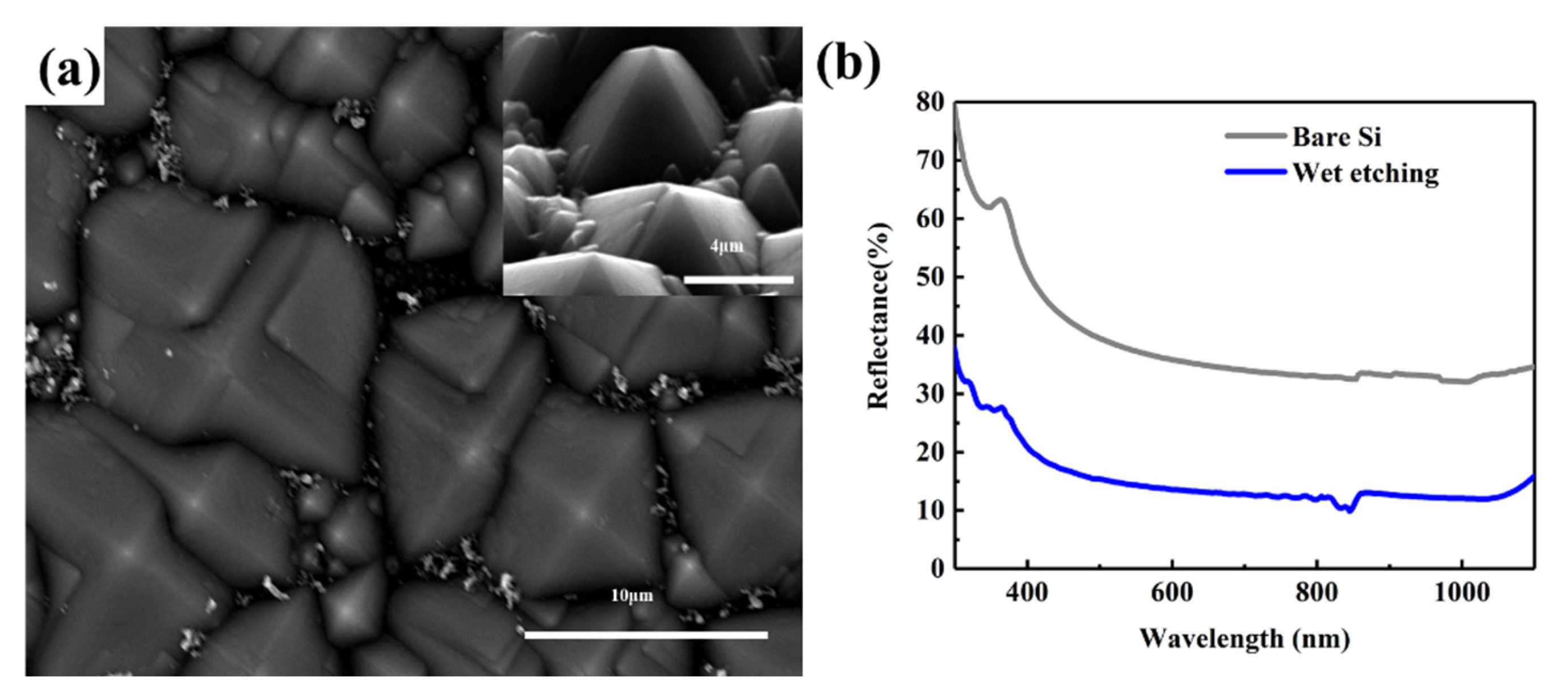

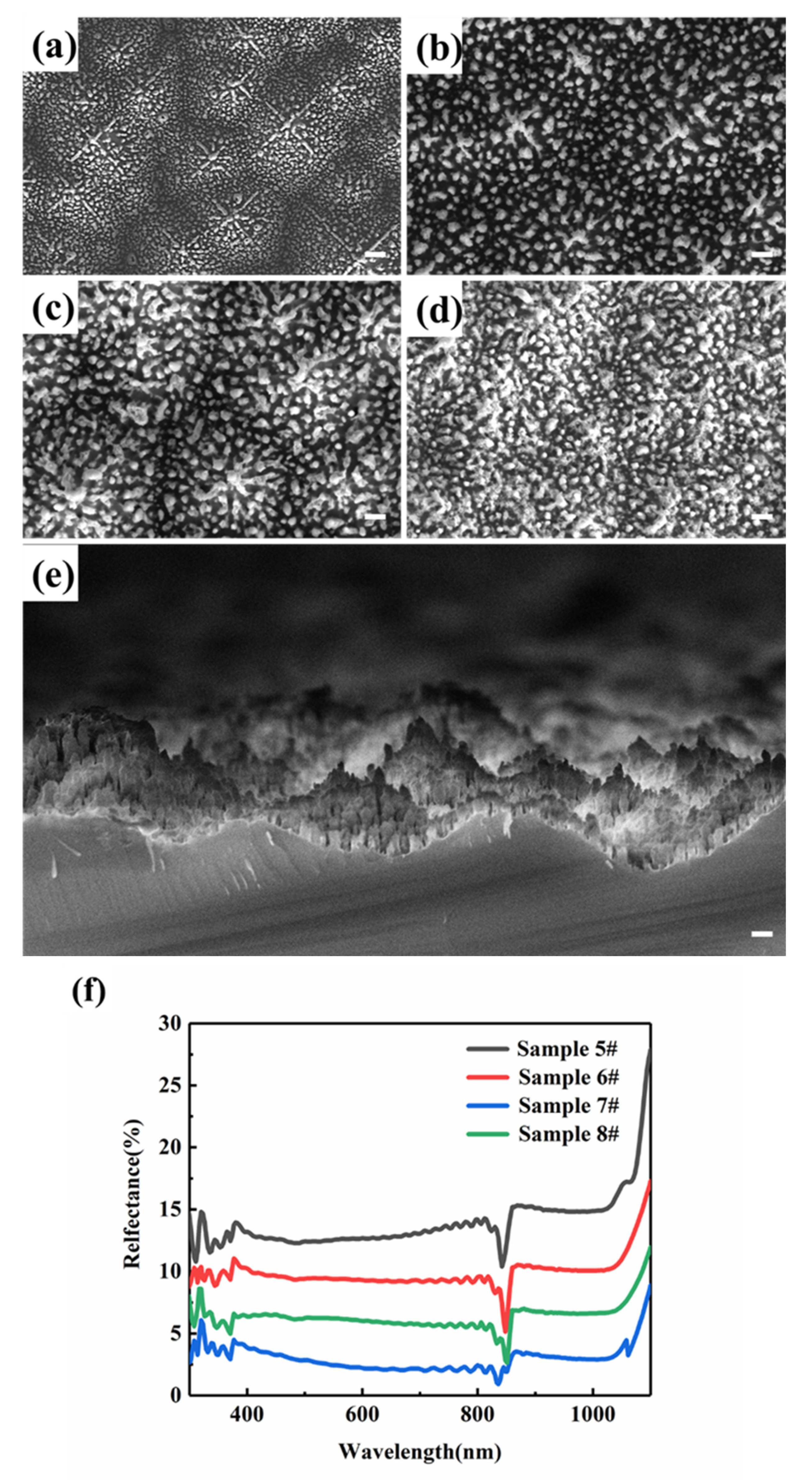
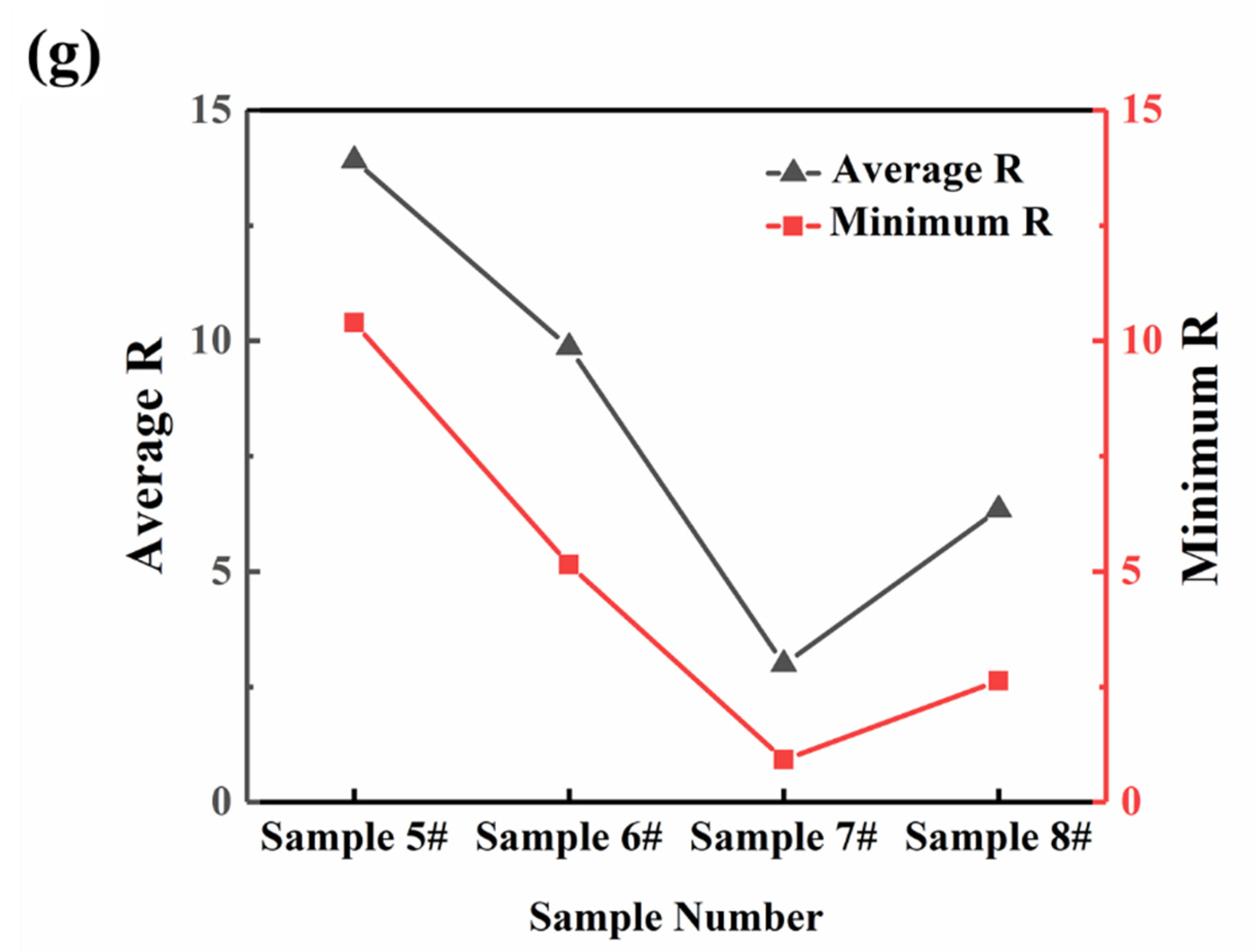

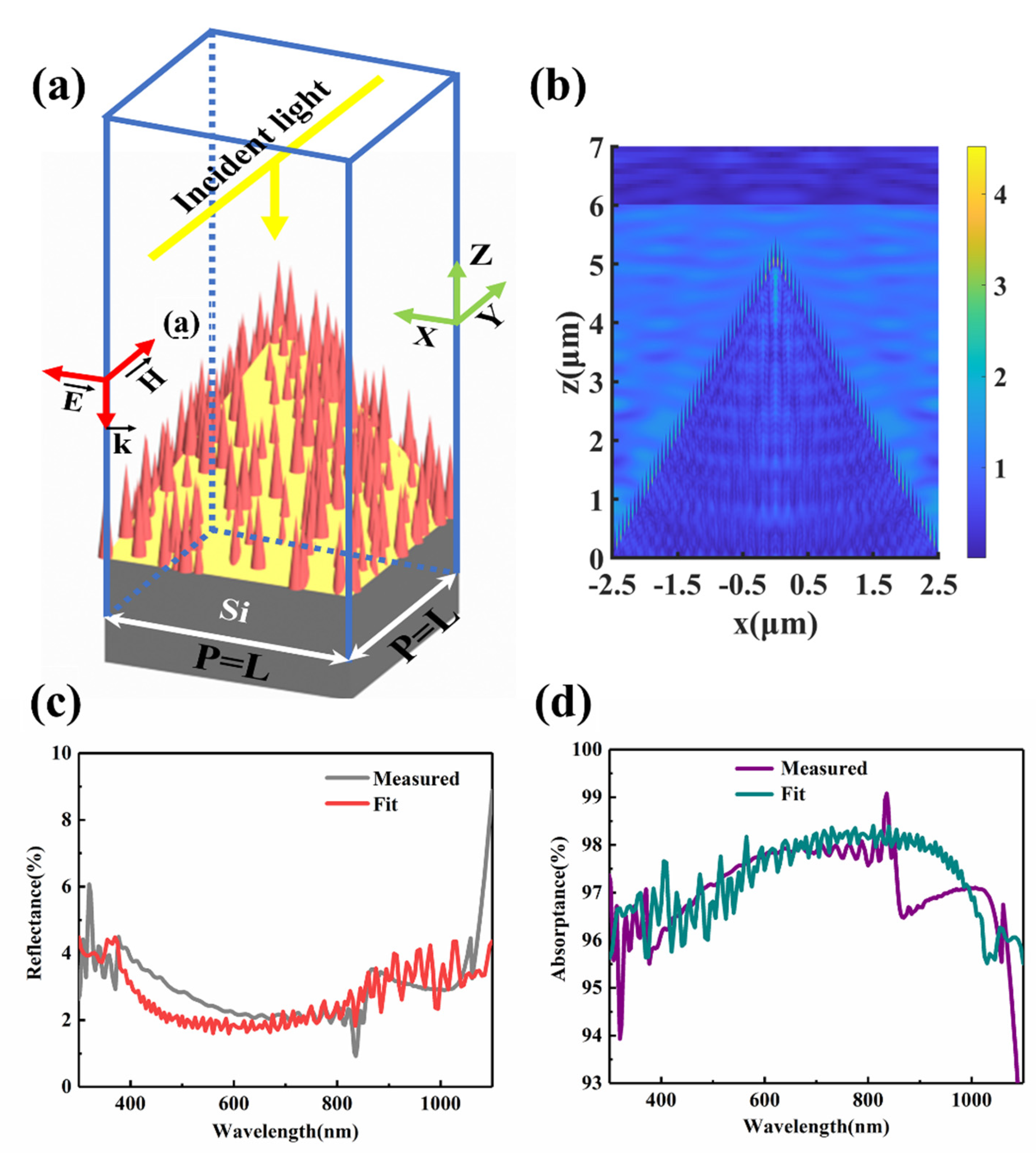

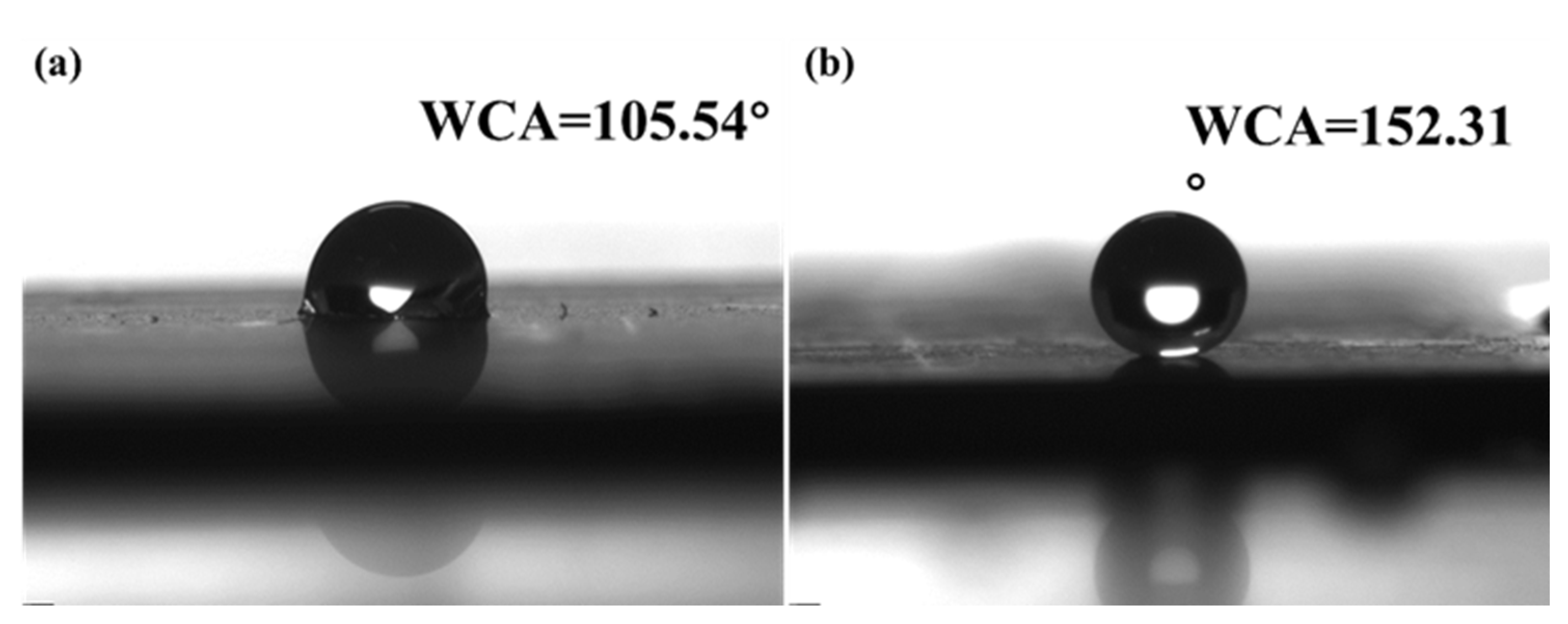
| Minimum Reflectance | Wavelength Range | Wettability | References |
|---|---|---|---|
| 0.92% | 300 nm~1100 nm | super-hydrophobic | this work |
| 1.27% | 300 nm~800 nm | hydrophobic | [2] |
| 2.5% | 300 nm~1200 nm | uncharacterized | [28] |
| ~5% | 200 nm~1100 nm | super-hydrophobic | [42] |
| ~1% | 350 nm~1100 nm | super-hydrophilic | [43] |
| 1.3% | 300 nm~1100 nm | uncharacterized | [44] |
| No. | Etching Time (min) | Gas Ratio (SF6:CHF3:He sccm) | Pressure (Pa) | Power (W) |
|---|---|---|---|---|
| 1# | 10 | 50:30:50 | 5 | 300 |
| 2# | 15 | |||
| 3# | 20 | |||
| 4# | 25 |
| No. | Wet Etching | Etching Time (min) | Gas Ratio (SF6:CHF3:He sccm) | Pressure (Pa) | Power (W) |
|---|---|---|---|---|---|
| 5# | KOH (500 mL) + IPA (100 mL) 15 min 80 °C | 10 | 50:30:50 | 5 | 300 |
| 6# | 15 | ||||
| 7# | 20 | ||||
| 8# | 25 |
Publisher’s Note: MDPI stays neutral with regard to jurisdictional claims in published maps and institutional affiliations. |
© 2021 by the authors. Licensee MDPI, Basel, Switzerland. This article is an open access article distributed under the terms and conditions of the Creative Commons Attribution (CC BY) license (https://creativecommons.org/licenses/by/4.0/).
Share and Cite
Duan, M.; Wu, J.; Zhang, Y.; Zhang, N.; Chen, J.; Lei, Z.; Yi, Z.; Ye, X. Ultra-Low-Reflective, Self-Cleaning Surface by Fabrication Dual-Scale Hierarchical Optical Structures on Silicon. Coatings 2021, 11, 1541. https://doi.org/10.3390/coatings11121541
Duan M, Wu J, Zhang Y, Zhang N, Chen J, Lei Z, Yi Z, Ye X. Ultra-Low-Reflective, Self-Cleaning Surface by Fabrication Dual-Scale Hierarchical Optical Structures on Silicon. Coatings. 2021; 11(12):1541. https://doi.org/10.3390/coatings11121541
Chicago/Turabian StyleDuan, Miaomiao, Jingjun Wu, Yubin Zhang, Ning Zhang, Jun Chen, Zhenhua Lei, Zao Yi, and Xin Ye. 2021. "Ultra-Low-Reflective, Self-Cleaning Surface by Fabrication Dual-Scale Hierarchical Optical Structures on Silicon" Coatings 11, no. 12: 1541. https://doi.org/10.3390/coatings11121541
APA StyleDuan, M., Wu, J., Zhang, Y., Zhang, N., Chen, J., Lei, Z., Yi, Z., & Ye, X. (2021). Ultra-Low-Reflective, Self-Cleaning Surface by Fabrication Dual-Scale Hierarchical Optical Structures on Silicon. Coatings, 11(12), 1541. https://doi.org/10.3390/coatings11121541







